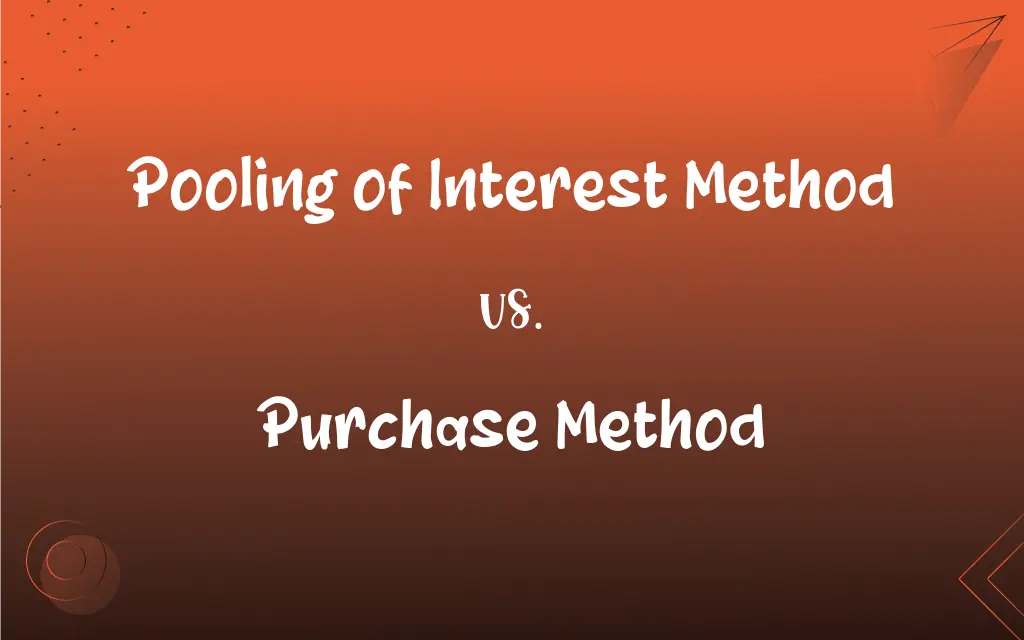Pooling of Interest Method vs. Purchase Method: What's the Difference?
Edited by Aimie Carlson || By Harlon Moss || Published on February 4, 2024
Pooling of interest method combines balance sheets of merging companies as equals. Purchase method records the acquisition at fair market value, recognizing goodwill.

Key Differences
The pooling of interest method treats the companies involved in a merger as equals, combining their assets and liabilities. The purchase method, on the other hand, involves one company acquiring another and reflecting the acquisition at its fair market value.
Under the pooling of interest method, financial statements of the merging entities are retroactively restated as if they have always been one entity. In the purchase method, the acquiring company records the assets and liabilities of the acquired company at their fair market values at the acquisition date.
No goodwill is recognized in the pooling of interest method, as it assumes that the merging companies are of equal value. In contrast, the purchase method often results in recognizing goodwill, representing the excess of purchase price over the fair value of net identifiable assets.
The pooling of interest method is less common and was largely replaced by the purchase method due to changes in accounting standards. The purchase method is widely used and aligns with most international accounting standards, including IFRS and US GAAP.
In the pooling of interest method, the historical costs of assets and liabilities are carried forward. In the purchase method, adjustments may be made to bring assets and liabilities to their current market values.
ADVERTISEMENT
Comparison Chart
Recognition of Assets/Liabilities
Combined at historical cost
Recorded at fair market value
Goodwill Recognition
No goodwill recognized
Goodwill recognized if purchase price exceeds fair value
Financial Statement Treatment
Retroactive restatement as a single entity
Assets and liabilities of the acquired entity are integrated at current values
Usage
Less common, mostly outdated
Widely used in compliance with international standards
Assumption
Treats merging companies as equals
Reflects an acquisition by one company of another
ADVERTISEMENT
Pooling of Interest Method and Purchase Method Definitions
Pooling of Interest Method
Combines balance sheets of companies as if they have always been one entity.
In their merger, they adopted the pooling of interest method to reflect a long-term partnership.
Purchase Method
Acquisition accounting where assets and liabilities are recorded at fair market value.
They used the purchase method, recording the acquired assets at their current market values.
Pooling of Interest Method
No recognition of goodwill in the merging process.
By using the pooling of interest method, they avoided any goodwill amortization issues.
Purchase Method
Used in compliance with international accounting standards.
They adopted the purchase method to align with US GAAP for their international acquisition.
Pooling of Interest Method
A method where financial statements of merging companies are combined.
The merger used the pooling of interest method, combining both companies' financial histories.
Purchase Method
Reflects an acquisition by one company of another.
The company's acquisition of its competitor was accounted for using the purchase method.
Pooling of Interest Method
Historical costs of assets and liabilities are carried forward.
The pooling of interest method allowed the merged company to retain its historical asset values.
Purchase Method
Recognizes goodwill as an excess of purchase price over fair value of net assets.
The purchase method led to a significant amount of goodwill due to the high purchase price.
Pooling of Interest Method
Merging entities are treated equally in financial representation.
The pooling of interest method was ideal since both companies were of similar size and value.
Purchase Method
Integrates the financial statements of the acquired company at current values.
Post-acquisition, the purchase method helped in reflecting the acquired assets at their revised values.
FAQs
What standards does the purchase method align with?
It aligns with international standards like IFRS and US GAAP.
Can pooling of interest method create goodwill?
No, it doesn’t recognize goodwill in the merging process.
How does the purchase method handle goodwill?
It recognizes goodwill if the purchase price exceeds the fair value of the acquired company's net assets.
Does pooling of interest method affect historical costs?
No, it carries forward the historical costs of assets and liabilities.
How are assets valued in pooling of interest method?
Assets are valued at their historical cost from before the merger.
What is the pooling of interest method in mergers?
It's an accounting method where merging companies' financial statements are combined as equals.
How does purchase method impact company's balance sheet?
It reflects the acquisition at fair market value, altering the balance sheet.
Why is pooling of interest method less preferred now?
Due to its lack of transparency and complexity in reflecting true company value.
Is pooling of interest method still widely used?
No, it's less common now due to changes in accounting standards.
Is purchase method suitable for equal-sized mergers?
It's generally used for acquisitions rather than equal mergers.
What happens to liabilities in the purchase method?
They are recorded at their fair market value at the time of acquisition.
Is pooling of interest method compliant with current GAAP?
No, it's generally not compliant with current GAAP, which favors the purchase method.
What are the tax implications of the purchase method?
The purchase method can have tax implications, particularly in the treatment of goodwill and depreciation.
Which method is better for reflecting market value?
The purchase method is generally better for reflecting the current market value of assets and liabilities.
Can small businesses use the purchase method?
Yes, small businesses can use the purchase method, especially when acquiring another company or assets.
Does the purchase method affect company earnings?
Yes, it can affect earnings, especially through the amortization of recognized goodwill.
Can the pooling of interest method be used in international mergers?
Its use is limited, especially where international accounting standards prefer the purchase method.
How does the purchase method handle depreciation?
Assets acquired are depreciated based on their fair market value at the time of purchase.
How does pooling of interest impact future financial reports?
It combines the past financial records of both companies, affecting future financial reporting.
Is goodwill amortization required in pooling of interest method?
No, since goodwill is not recognized in the pooling of interest method, there's no amortization.
About Author
Written by
Harlon MossHarlon is a seasoned quality moderator and accomplished content writer for Difference Wiki. An alumnus of the prestigious University of California, he earned his degree in Computer Science. Leveraging his academic background, Harlon brings a meticulous and informed perspective to his work, ensuring content accuracy and excellence.
Edited by
Aimie CarlsonAimie Carlson, holding a master's degree in English literature, is a fervent English language enthusiast. She lends her writing talents to Difference Wiki, a prominent website that specializes in comparisons, offering readers insightful analyses that both captivate and inform.







































































